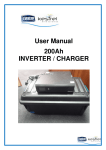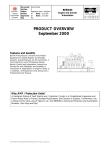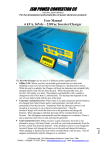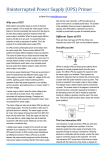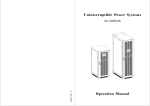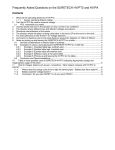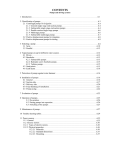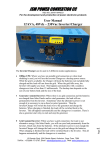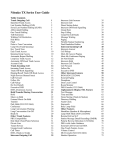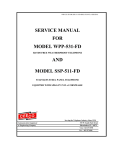Download 52SJ user manual us WESCO
Transcript
Power Quality paper #1 Causes of voltage dips & resulting problems By: G J Coetzee 0 OVERVIEW The smooth operation of industrial, manufacturing and mining plants (will be referred to as a ‘plant’) are dependent on a steady power supply. Dips in the supply voltage (depressions in supply voltage of short duration) can lead to unnecessary stoppage of plant processes unless adequate measures have been taken in the design of the electrical equipment. The capital losses to a plant when process are interrupted varies significantly depending on the type of plant. Production can be affected when normal operation of a plant cannot be restored in a reasonable time. Further, some plants may require capital outlay in order to restore normal operation. At some plants, the safety of personal may be affected during the loss of operation. In many cases, corrective measures can be taken on the electrical and control equipment to prevent the loss of the process of a plant during voltage dips. 1 1.1 DEFINITIONS VOLTAGE DIP WHEN DISCONNECTED FROM THE SUPPLY A plant can be completely disconnected from its supply and be re-connected within a few seconds. The supply voltage can be as low as zero during the time the plant is disconnected. 1.2 VOLTAGE DIP WHILE CONNECTED TO THE SUPPLY SYSTEM Voltage dips can occur while connected to the supply system. It is important to distinguish between this type of voltage dip and the dips described in 1.1 above as the performance of electrical plant during these two types of dip is different. 1.3 SYSTEMS AND SUBSYSTEMS An industrial plant can consist of several systems, each performing a specific function.These systems may have subsystems, serving a system. An example would be a motor driven fan system supplying a draught to the plant process and a lubricator-pump-subsystem supplying the bearings of the fan and/or motor. 1.4 INERTIA OF A SYSTEM Systems or subsystems have various forms of inertia enabling them to withstand a temporary loss of energy supplied from the electrical system before reaching a critical stage where the process must be discontinued. As an example, a lubrication oil pump may have a gravity fed conservator tank maintaining pressure while the pump is temporary out of operation. 1.5 ESSENTIAL AND CRITICAL SYSTEMS The operation of some system could be essential to maintain the plant process. Such a system could be referred to as an ‘essential’ system from a voltage dip point of view. However, the operation of some systems could be very sensitive to maintain the process in the short term during supply interruptions. These are usually systems that cannot be restarted by the operator in a reasonable time before the process must be discontinued. These systems can be referred to as a ‘critical’ system in the plant from a voltage dip point of view. DIP-PROOFING TECHNOLOGIES INC. DPI Binder Rev 1.0 Page 1 Power Quality paper #1 2 CAUSES OF VOLTAGE DIPS 2.1 TEMPORARY LOSS OF SUPPLY The supply to a plant can be temporarily disconnected for a short duration and the electrical plant can be controlled to resume operation immediately after the supply recovers, maintaining operation of the process. Sources of this type of voltage dips are usually Automatic Reclose (ARC) dead times and switch over from one supply to another supply-source. 2.2 SHORT CIRCUITS The supply voltage to a plant will dip when a short circuit occurs on the supply side or within the plant distribution medium or low voltage system. The latter faults usually are of concern as the depth of the voltage dip can be 100%, i.e. the supply voltage could fall to zero. Also, the clearing times of faults on internal distribution systems are normally longer than for faults on the supply side. 2.3 LOAD SWITCHING Switching of load onto the supply can result in partial voltage dips. Major problems could be experienced when large direct on line induction motors are being started. A plant could be effected by switching taking place inside the plant or external to the supply system. 2.4 NETWORK SWITCHING Switching on either the supply system or the plant internal distribution network can result in various types of voltage dips. Paralleling two supplies running at different load angles will result in a fast transient voltage change followed by a dynamic condition before settling at the new steady state load angle. The transient changeover is usually fast and it is unlikely to have an effect on normal electrical plant, unless the plant is very sensitive to voltage dips such as may be the case for power electronic equipment. 2.5 POWER SWINGS When the supply network is weakened by the loss of transmission lines or after severe faults on the supply network, power swings between generating stations lasting several seconds can occur on the network. 3 3.1 TYPICAL CHARACTERISTICS OF VOLTAGE DEPRESSIONS SHORT CIRCUIT FOLLOWED BY A DYNAMIC CONDITION The terminal voltage of a plant during a short circuit will depend on: • The impedance of the fault • The location of the fault The terminal voltage, for faults of low impedance close to or at the plant, will be close to zero. As the position of the fault moves away into a parallel supplied network, the supplied voltage during the fault will increase. Faults inside the distribution network of a plant will always result in a low terminal voltage at the point of fault but may not necessarily affect the entire plant should the fault occur at a point where the impedance between the point of fault and the point of supply is high. Thus it is important to note that it is possible that only a part of a Page 2 DIP-PROOFING DPI Binder Rev 1.0 TECHNOLOGIES INC. Power Quality paper #1 plant may be subjected to a serious voltage dip. 1.2 11kV Board terminal voltage 1.1 Voltage (pu) During the fault, induction motor drives will lose speed and have to re-accelerate after the fault has cleared. On a relatively weak supply with large induction motor loads, this current, may affect the terminal voltage as well as overload the supply system. The current drawn by the motor during such a condition will depend on the load torque, the inertia (rotating stored energy) of the drive, and the duration of the fault. High inertia- drives (H > 6) after a fault of short duration (< 100 ms) will typically draw a fraction of the starting current. As the fault duration increases, the currents drawn by the motors will approach full starting current and the duration of the re-acceleration currents will increase. Examples of voltage curves and starting currents are shown in Fig 1 to Fig 6 for the system shown in Fig 7. The voltage during the fault may not necessary remain the same as the impedance of the fault may vary. 1.0 0.9 Fault Duration: 50mS 100mS 0.8 150mS 200mS 0.0 0.2 0.4 0.6 0.8 1.0 1.2 1.4 1.6 1.8 0.7 2.0 Time Fig 1 3.2 FAR END OF LINE TRIPPING DURING FAULT DIP-PROOFING TECHNOLOGIES INC. DPI Binder Rev 1.0 Page 3 1.2 11kV Board terminal voltage 1.1 Voltage (pu) Power Quality paper #1 1.0 0.9 Fault Duration: 200mS 250mS 0.8 300mS 350mS 0.0 0.2 0.4 0.6 0.8 1.0 1.2 1.4 1.6 1.8 0.7 2.0 Time 1.2 11kV Board terminal voltage 1.1 Voltage (pu) Fig 2 1.0 0.9 Fault Duration: 50mS 100mS 0.8 150mS 200mS 0.0 0.2 0.4 0.6 0.8 1.0 1.2 1.4 1.6 1.8 0.7 2.0 Time Fig 3 Page 4 DIP-PROOFING DPI Binder Rev 1.0 TECHNOLOGIES INC. Power Quality paper #1 25 MVA MVA drawn by 11kV feeder 20 15 Fault Duration: 50mS 10 100mS 150mS 200mS 0.0 0.2 0.4 0.6 0.8 1.0 1.2 1.4 1.6 5 0 2.0 1.8 Time Fig 4 25 MVA MVA drawn by 11kV feeder 20 15 Fault Duration: 200mS 10 250mS 300mS 350mS 0.0 0.2 0.4 0.6 0.8 1.0 1.2 1.4 1.6 1.8 5 0 2.0 Time Fig 5 DIP-PROOFING TECHNOLOGIES INC. DPI Binder Rev 1.0 Page 5 Power Quality paper #1 25 MVA MVA drawn by 11kV feeder 20 15 Fault Duration: 350mS 10 400mS 450mS 500mS 0.0 0.2 0.4 0.6 0.8 1.0 1.2 1.4 1.6 1.8 5 0 2.0 Time Fig 6 Infinite busbar XFL = 0.002 pu (Supply fault level) 11kV Busbar XTRFR = 0.04 pu (Impedance of Trfr) 525V Busbar 6 off 270kw Motors with H = 0.4sec All impedances are at 525V & 6 x 270kw base Fig 7 Case study network details Page 6 DIP-PROOFING DPI Binder Rev 1.0 TECHNOLOGIES INC. Power Quality paper #1 When a fault occurs on one of several parallel feeders supplying a plant, the time at which the fault clears on the plant side of the line, and on the far end of the line, could be different. Fig 8 shows a typical example of the terminal voltage where the far end of the line opens after the plant side, for a fault near the plant. Voltage (pu) 1 pu 3.3 Re-acceleration of motors Breaker opening at far end of line Breaker opening at plant side Time Fig 8 Voltage during a severe short circuit close to the point of supply and cleared by line protection. BACK GENERATION OF MOTORS When the supply to a plant is disconnected, the motors will back-generate and the voltage will not instantaneously fall to zero. Motors with low inertias and high load torques can stall within 150 ms and the back generated voltage will decay quickly due to the rapid decay in shaft speed. On a plant where one or more large motors with high inertias operates (such as fans) the terminal voltage will decay with a time constant as long as 1.5 seconds. This slow decay in voltage will reduce the deceleration of other small inertia low load torque motors connected to the same busbar. 3.4 LOSS OF SUPPLY DUE TO ARC DEAD TIME The dead time for a three phase automatic reclosure (ARC) network is normally within 3 to 5 seconds. For a single phase trip, which is a partial loss of supply, the ARC dead time is set as low a 1 second. 3.5 UNBALANCE OF SUPPLY The magnitude of unbalance in the three phase supply voltage is as important as the magnitude of a voltage dip. The torque of a three phase induction motor drive is dependant on the positive phase sequence component of the supply voltage. The presence of negative phase sequence components in the supply voltage will reduce the motor applied torque. It is thus important that any form of busbar voltage condition monitoring relay should not only sense the magnitude of the voltages, but also sense the negative phase sequence component. Such a relay will verify that the supply voltage is adequate to drive three phase motors: A high negative phase sequence component can be present on the supply voltage, depending on the network configuration, during the dead time of a single phase ARC. 3.6 POWER SWINGS During a large power swing on the network, the terminal voltage at a plant can oscillate at a frequency between 0.1 and 2 Hz with minimum values as low as 65 %. Such power swings normally last only for a few seconds but under severe weak interconnected network conditions, the oscillations may continue for several tens of seconds. The electrical equipment of an industrial plant, if correctly designed, can DIP-PROOFING TECHNOLOGIES INC. DPI Binder Rev 1.0 Page 7 Power Quality paper #1 continue operation during such voltage dips. This type of voltage dip is unlikely to occur on an industrial plant which is supplied from a strong point in the national network. 3.7 SWITCHING OF LOADS Voltage dips can be generated on a plant supplied by a relatively weak network, when large direct on-line induction motors are started. The duration of these voltage dips is dependant on the starting time of the motors. 4 4.1 EFFECTS OF VOLTAGE DIPS ON INDUSTRIAL PLANT IMPACT ON THE PROCESS When a voltage dip occurs on the supply of an industrial plant, various parts of the plant process will rapidly approach a point where the process must be discontinued in order to safeguard the plant. It is essential to know the time it takes from the initiation of the voltage dip to the time when the process must be discontinued for a plant, before any counter measures can be designed. It is also important to arrange the electrical supply equipment in such a manner that its outage time is minimized following a voltage dip. Unsuccessful ARC of transmission lines can result in a second voltage dip. It is thus important to restore the plant process as soon as possible after voltage restoration. 4.2 DROPOUT OF CONTACTORS A common problem with Low Voltage (LV) switchgear is that the electrically held in contactors fall out during voltage dips. The supply controlling the contactors is normally taken directly from the associated busbar supply voltage. When the control voltage falls below 70% of its nominal value, the contactor may open and the seal-in contact will open. LV drives may thus stop when a voltage dip occurs. 4.3 VARIABLE SPEED DRIVES Smooth operation of Variable Speed Drives (VSD) following a voltage dip is not possible on all types of VSD’s. The operation of firing circuits controlling power electronics such as thyristors cannot be maintained when the voltage falls to a low level and the drive must be stopped. On some types of VSDs it is possible to turn the firing of thyristors off immediately when a large voltage dip is detected and then carefully start the firing once the supply voltage has recovered. Careful consideration should thus be given when selecting VSDs which will drive loads essential to maintain the plant process. The control of VSDs during small voltage dips of long duration should also be taken into account when selecting VSDs. 4.4 CONTROL EQUIPMENT SUPPLIES The application of control equipment such as Programmable Logic Controllers (PLC) in plants is very common. However, this type of control equipment requires a standby supply. Care should be taken that the supply to such equipment is secure against voltage dips. Alternatively, the outputs of a PLC can be switched off in the event of a voltage dip of a magnitude and duration which can damage plant or the process. 4.5 PROTECTION The setting of protection relays plays a major role in the smooth operation of a plant during voltage dips. The incomer, transformer, MV switchgear and motor protection relay settings must be correctly set in a coordinated manner. Page 8 DIP-PROOFING DPI Binder Rev 1.0 TECHNOLOGIES INC. Power Quality paper #1 The following points are of importance: The co-ordination of electrical protection relay settings with the dynamic currents which will flow when the voltage recovers after a voltage dip must be taken into account. The settings of all under voltage relays and their associated timers on the entire plant should be coordinated to make maximum plant available during a voltage dip without exceeding the capability of the equipment. In many instances a sub contractor supplies a sub-system with its associated protection incorporated in his scope of supply. It should be verified that all under voltage protection relay settings are consistent throughout the plant. Often protection equipment is set to trip for a condition without any time delay. An example would be a lubrication oil pressure sensor tripping a system immediately when the pressure falls below a preset value. It may be within the capability of the plant to operate for a few seconds at a low pressure without damaging the plant. By introducing time delays on protection trip signals with discretion, the operating range of the plant can be increased to allow short interruptions. 5 CONCLUSIONS Any electrical system is vulnerable to short circuits, although some more than others, which will lead to voltage dips. If the effect of voltage dips is taken into consideration during the design phase of a plant, the best method can be implemented to ensure the smooth running of a plant. This is not always considered during the design phase of the plant and action is taken only when the problem reveals itself during the commissioning phase. A great deal of information on the supply system and the plant process is required before decisions can be made on appropriate counter measures to avoid loss of production during voltage dips. Paper: Causes of voltage dips & resulting problems By: G J Coetzee - Senior Consultant, Eskom MW Park, Generation Technology Department, PO Box 1092, Johannesburg, 2000 DIP-PROOFING TECHNOLOGIES INC. DPI Binder Rev 1.0 Page 9









